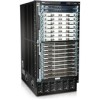Dell PowerConnect J-8216 Hardware Guide - Page 144
Connecting a Fiber-Optic Cable to an Optical Transceiver, Installed in a J-EX Series Switch
 |
View all Dell PowerConnect J-8216 manuals
Add to My Manuals
Save this manual to your list of manuals |
Page 144 highlights
g027016 Dell PowerConnect J-Series J-EX8216 Ethernet Switch Hardware Guide To connect a fiber-optic cable to an optical transceiver installed in a J-EX Series switch: WARNING: Do not look directly into a fiber-optic transceiver or into the ends of fiber-optic cables. Fiber-optic transceivers and fiber-optic cables connected to transceivers emit laser light that can damage your eyes. 1. If the fiber-optic cable connector is covered by a rubber safety cap, remove the cap. Save the cap. 2. Remove the rubber safety cap from the optical transceiver. Save the cap. 3. Insert the cable connector into the optical transceiver (see Figure 56 on page 128). Figure 56: Connecting a Fiber-Optic Cable to an Optical Transceiver Installed in a J-EX Series Switch Transceiver Fiber-optic cable 4. Secure the cables so that they are not supporting their own weight. Place excess cable out of the way in a neatly coiled loop. Placing fasteners on a loop helps cables maintain their shape. CAUTION: Do not bend fiber-optic cables beyond their minimum bend radius. An arc smaller than a few inches in diameter can damage the cables and cause problems that are difficult to diagnose. Do not let fiber-optic cables hang free from the connector. Do not allow fastened loops of cables to dangle, which stresses the cables at the fastening point. Related • Disconnecting a Fiber-Optic Cable from a J-EX Series Switch on page 170 Documentation • Installing a Transceiver in a J-EX Series Switch on page 126 • Maintaining Fiber-Optic Cables in J-EX Series Switches on page 179 • Optical Interface Support in J-EX8200 Switches on page 51 128















